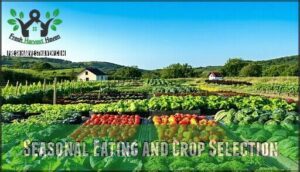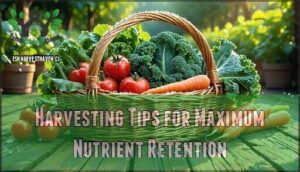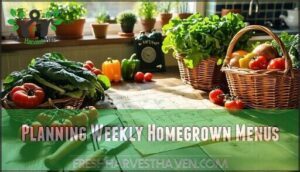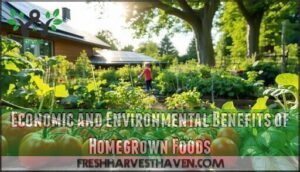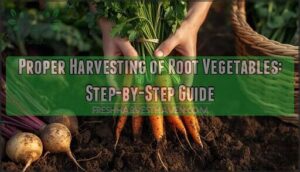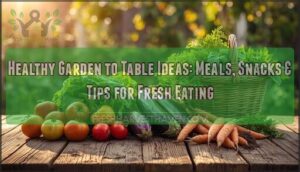This site is supported by our readers. We may earn a commission, at no cost to you, if you purchase through links.
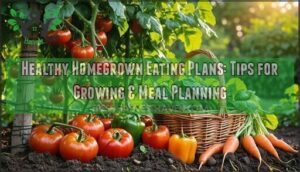
That connection matters more than you might think. When you grow your own fruits and vegetables and build meals around what’s thriving in your garden, you’re not just eating differently—you’re naturally gravitating toward the nutrient-dense, whole foods your body actually needs.
This approach to healthy homegrown eating plans transforms nutrition from a chore into something that feels instinctive and satisfying.
Table Of Contents
- Key Takeaways
- Key Elements of a Healthy Homegrown Diet
- How to Grow and Plan Nutritious Meals
- Homegrown Eating for Disease Prevention
- Economic and Environmental Benefits of Homegrown Foods
- Lifestyle Tips for Sustainable Healthy Eating
- Frequently Asked Questions (FAQs)
- What is the 3 3 3 rule eating?
- What is the 5 4 3 2 1 diet plan?
- What is the 80% rule in eating?
- What is the healthiest eating plan?
- How do I preserve homegrown foods long-term?
- What equipment is needed for home gardening?
- Can children safely help with growing food?
- How much time does home gardening require weekly?
- What are common beginner mistakes to avoid?
- Conclusion
Key Takeaways
- Growing your own fruits and vegetables delivers more nutrients at peak ripeness than store-bought produce, with homegrown options showing up to 50% higher vitamin C levels and greater antioxidant content that strengthens your immune system and reduces inflammation.
- Plant-based eating patterns from homegrown gardens significantly lower chronic disease risk, including a 52% reduction in heart disease risk and a 20% decrease in coronary heart disease when you eat three daily servings of whole grains alongside fresh produce.
- Home gardens cut grocery costs substantially while supporting environmental health—a single $3 tomato plant yields 10-30 pounds of fruit, and choosing seasonal local produce reduces food-system emissions by about 20% compared to conventionally transported foods.
- Successful homegrown eating plans combine smart harvesting techniques (picking produce early morning for maximum nutrients), gentle cooking methods like steaming that preserve vitamins, and meal planning that rotates seasonal crops to prevent waste while maintaining balanced nutrition.
Key Elements of a Healthy Homegrown Diet
Building a healthy homegrown eating plan starts with understanding which foods your body needs most. You’ll want to focus on variety, balance, and nutrient density when choosing what to grow and eat.
Let’s look at the essential food groups that form the foundation of any solid nutrition plan.
Essential Food Groups for Balanced Nutrition
Building a strong foundation starts with knowing your food groups. When you’re growing and eating your own food, aim to include these essentials daily:
- Fruits and vegetables – Pack your meals with garden-fresh produce for vitamins and minerals
- Whole grains and plant proteins – Think beans, legumes, and fiber-rich grains for lasting energy
- Healthy fats and omega-3 sources – Use nuts and certain fish to support heart and brain health
Balanced nutrition means hitting all these food groups consistently. It’s important to understand different types of food for peak health.
Your homegrown eating plan should reflect your nutrient needs while keeping meal planning simple and sustainable.
Role of Fresh Fruits and Vegetables
Fresh fruits and vegetables from your garden don’t just taste better—they deliver more vitamins, antioxidants, and minerals than what you’ll find on most grocery store shelves. When you harvest at peak ripeness, you’re getting nutrients at their highest levels—which means better inflammation reduction and a stronger immune system for your body.
Garden-fresh produce harvested at peak ripeness delivers more vitamins, antioxidants, and minerals than grocery store alternatives, strengthening your immune system naturally
| Nutrient | Homegrown Advantage | Health Benefit |
|---|---|---|
| Vitamin C | 50% higher in fresh-picked produce | Immune health |
| Beta-carotene | Considerably more in homegrown carrots | Protects vision and skin |
| Folate | Greater retention in leafy greens | Aids cell growth and repair |
These nutrient-rich foods also provide dietary fiber while aiding your meal planning goals with healthy food choices you can trust.
Importance of Whole Grains and Plant Proteins
Beyond fresh produce, you’ll also want to stock your homegrown meals with whole grains and plant proteins—two powerhouse food groups that work together to keep your heart healthy, your energy steady, and your disease risk down.
Whole grains like quinoa and oats are high in dietary fiber, which lowers cholesterol and aids healthy eating patterns.
Beans and legumes pack plant-based proteins with legume power that reduces disease risk while adding nutrient density to your meal planning routine.
Healthy Fats and Omega-3 Sources
Your body also needs the right kinds of fat—think of "good" unsaturated fats and omega-3 fatty acids as the oil that keeps your engine running smoothly. Omega-3 benefits include supporting your heart and brain health, while unsaturated fat types like those in olive oil help reduce inflammation.
You’ll find healthy fat sources in nuts, seeds, and fish rich in omega-3s. When choosing cooking oils, reach for olive oil or avocado oil—both deliver unsaturated fats that your body can actually use.
How to Grow and Plan Nutritious Meals
Growing your own food and turning it into meals takes a bit of know-how, but you don’t need to be an expert to start. This section walks you through the basics—from planting your first seeds to putting homegrown ingredients on your plate.
Here’s what you need to get started and keep your kitchen stocked with fresh, nutrient-rich foods.
Starting a Home Garden for Beginners
Starting a home garden doesn’t require a green thumb or a sprawling backyard—just a willingness to get your hands dirty and learn as you go. Begin with easy-to-grow crops like tomatoes, lettuce, or herbs, which offer quick rewards and build your confidence. Focus on soil preparation first, as nutrient-rich soil is the foundation for healthy fruits and vegetables that’ll fuel your meal planning efforts.
Here’s what you’ll need to get started:
- Choose your space: A sunny windowsill, container on a balcony, or small garden bed works perfectly for beginners
- Test and enrich your soil: Add compost or organic matter to boost nutrients before planting
- Start small with seed selection: Pick 3-5 beginner-friendly varieties suited to your climate and available light
- Set up simple watering techniques: Consistent moisture matters more than fancy equipment—a watering can does the job
- Learn basic pest control: Handpicking pests and using natural deterrents keeps your produce safe for healthy food preparation
Seasonal Eating and Crop Selection
When crops hit peak ripeness at the right time of year, you’re not just getting better flavor—you’re also getting more nutrients for your meal planning. Aligning your planting patterns with local availability means your fruits and vegetables mature when nature intended, which promotes healthy eating while slashing your carbon footprint by up to 60%.
Smart crop rotation between plant families keeps soil healthy, boosts yields, and gives you diverse options for healthy food preparation all year long. Produce harvested in season also allows for peak flavor development.
Harvesting Tips for Maximum Nutrient Retention
The moment you pick a tomato or snip a handful of kale makes all the difference in how many vitamins actually land on your plate. Harvest early in the morning when nutrient content peaks, and treat produce gently to avoid bruising—damaged cells lose vitamins fast.
Store your harvest in cool, dark spots, or better yet, eat it right away to lock in those nutrient-rich minerals and antioxidants.
Planning Weekly Homegrown Menus
Once you’ve nailed the harvest, turning those fresh picks into actual meals is where the real magic—and convenience—happens. Start with weekly meal prep that follows your garden-to-table balance—pair leafy greens with whole grains, toss in plant proteins, and rotate crops into your seasonal recipe planning.
Use proper homegrown food storage to keep nutrients locked in, practice portion control during home cooking, and let menu crop rotation guide your healthy eating rhythm so nothing goes to waste.
Homegrown Eating for Disease Prevention
Your homegrown garden can be a powerful ally in preventing chronic diseases. The fresh produce you cultivate at home delivers nutrients that protect your heart, balance your blood sugar, reduce inflammation, and strengthen your immune system.
Let’s look at how eating what you grow helps you stay healthier for the long haul.
Reducing Risk of Heart Disease and Stroke
Your dietary choices play a powerful role in protecting your heart. People who eat more plant-based foods have a 52% lower chance of developing heart disease, and eating three servings of whole grains daily cuts coronary heart disease risk by about 20%.
When you load up on fruits, vegetables, whole grains, and healthy fats from sources like vegetable oils, you’re giving your cardiovascular system what it needs to stay strong. Plus, gardening itself counts as physical activity that aids heart health.
Managing Blood Sugar and Weight
Managing blood sugar isn’t rocket science—it’s about balance. Home-cooked meals, served five or more times per week, can lower your risk of excess body fat by 24%. When you adjust dietary macronutrients to a 30:20:50 ratio (protein:carbohydrate:fat), you’ll see real results.
Add whole grains daily for weight management, practice portion control with meal planning, and swap high-glycemic foods for balanced diet staples. Meal timing matters too—eating homegrown produce means healthier eating patterns stick.
Lowering Inflammation With Fresh Produce
Fresh produce from your garden isn’t just nutrient-dense—it’s one of your best allies against chronic inflammation. Vegetables like leafy greens and fresh fruits are packed with phytonutrients that fight inflammation at the cellular level.
You’ll support gut health, strengthen immune support, and lower your risk of chronic disease.
That’s why healthy eating starts with meal planning around anti-inflammatory foods you grow yourself.
Supporting Immune Health Naturally
Your immune system runs on the same nutrients that help tame inflammation—vitamins, minerals, and antioxidants straight from the soil. Fresh greens boost gut health, while homegrown herbs offer natural immune support without relying on supplements.
Combine healthy eating with stress reduction and quality sleep, and you’re building a foundation that keeps your defenses strong year-round.
Economic and Environmental Benefits of Homegrown Foods
Growing your own food isn’t just about health—it’s also a smart financial move and a meaningful step toward protecting the planet. From cutting your grocery bills to reducing the environmental toll of food transport, homegrown eating creates ripple effects that benefit both your wallet and your community.
Let’s explore how cultivating your own produce delivers real economic and environmental advantages.
Saving Money on Groceries
Growing your own food isn’t just about health—it’s one of the smartest financial moves you can make. A simple backyard garden can slash your grocery bills while giving you fresher, more nutritious food. Here’s what you’ll save:
- Tomatoes: One $3 plant yields 10–30 pounds of fruit
- Lettuce: Continual harvests replace $4–6 weekly salad purchases
- Herbs: A $3 basil plant beats $3–5 per package at stores
- Zucchini: Two plants can produce more than most families need
Budget meal planning becomes easier when you grow your own seasonal produce, reduce food waste by harvesting only what you need, and make healthier food choices without the markup.
Supporting Local Economies and Jobs
When you choose homegrown or locally sourced food, you’re not just feeding your family—you’re keeping your neighbors employed. Small farms selling directly create nearly three times more jobs than wholesale operations.
These food choices strengthen local food resilience and help small farm viability, especially for farms earning under $350,000 annually. Home garden savings extend beyond your wallet—they support entire communities and promote healthy eating habits that last.
Reducing Food Miles and Carbon Footprint
Local sourcing can shrink your carbon footprint, but the full story is a bit more complex than you might think. Food miles make up about 20% of food-system emissions globally, so choosing seasonal produce from nearby farms does help.
That said, what you eat matters even more than where it comes from—swapping one beef meal for plants cuts more emissions than buying everything local.
Urban gardens offer climate wins when they replace lawns, but homegrown food choices work best paired with smart meal planning and healthy eating habits.
Enhancing Soil and Local Biodiversity
Turning your garden into a living ecosystem doesn’t just feed you—it feeds the soil, the pollinators, and what comes next for your backyard. Composting benefits soil health by adding nutrients naturally, while native plants attract bees and butterflies to your pollinator gardens.
This biodiversity impact strengthens your whole growing system, giving you healthier food and better meal planning options. Your healthy eating habits start with what thrives beneath your feet.
Lifestyle Tips for Sustainable Healthy Eating
Growing your own food is just the beginning—how you prepare and live with it matters too.
The way you cook, move, and connect with others can turn healthy eating into a lasting lifestyle.
Here’s how to make it all stick without burning out.
Cooking Methods to Preserve Nutrients
The way you cook your homegrown harvest can make or break its nutritional power—overcook those greens, and you’ll watch their vitamins vanish right down the drain. Here’s how to keep the nutrient content of food intact during meal planning and food preparation:
- Steaming vegetables locks in vitamins better than boiling
- Microwaving safely with minimal water preserves nutrient-rich foods
- Sautéing techniques using healthy fats improve absorption
- Slow cooking transforms tougher produce into nutrient-rich soups
- Quick cooking methods protect delicate compounds best
Managing Stress and Staying Active
Stress doesn’t just mess with your mood—it can sabotage your best efforts to eat well and stay healthy, turning your homegrown bounty into just another source of guilt instead of nourishment.
Combat this by pairing stress management with regular exercise—even 30 minutes of daily physical activity like gardening counts. Your active lifestyle aids mental well-being while meal planning becomes homegrown therapy, not another chore.
Building Family and Community Support for Healthy Habits
You can’t out-exercise a bad diet or out-garden stress alone—real change happens when the people around you join the journey.
Start family meal planning sessions together, join community garden initiatives, or create healthy habit challenges with peer support groups.
Intergenerational gardening builds stronger family eating habits while building a support system that reinforces your healthy lifestyle—because accountability mixed with encouragement turns temporary fixes into lasting transformation.
Frequently Asked Questions (FAQs)
What is the 3 3 3 rule eating?
Balancing your plate isn’t rocket science—it’s rhythm. Rule meal timing around three meals spaced evenly, each with three macronutrients (protein, carbs, fats), eaten within three hours of waking.
This fosters portion control, balanced meals, and sustainable adherence for healthy eating success.
What is the 5 4 3 2 1 diet plan?
This diet plan focuses on portion control and food variety: 5 servings of vegetables, 4 of fruits, 3 of lean proteins, 2 of healthy fats, and 1 hydration goal.
It simplifies meal planning without strict calorie counting.
What is the 80% rule in eating?
Picture someone at a dinner party, constantly pushing back from the table saying "I’m pleasantly full"—that’s the 80% rule in action. This approach to mindful eating suggests stopping when you’re about 80% satisfied, not stuffed.
It promotes better satiety signals, aids digestive health, and naturally encourages portion control without strict calorie restriction.
What is the healthiest eating plan?
Focus on dietary diversity, balanced macros, and nutrient density—hallmarks of Mediterranean diet principles.
Prioritize whole foods, practice portion control, maintain hydration habits, and follow dietary guidelines emphasizing vegetables, healthy fats, and lean proteins for best health.
How do I preserve homegrown foods long-term?
Freezing produce, canning methods, and food dehydration can "jar" your harvest into year-round nutrition. Root cellaring works for hardy crops, while fermentation techniques boost gut-friendly probiotics.
Proper food preparation and food safety make sure your dietary planning maintains peak nutrient intake.
What equipment is needed for home gardening?
Basic gardening hand tools, irrigation systems, soil testing kits, and pest control supplies get you started. Add seed starting trays for early planting.
Later, you’ll use these fresh ingredients for food preparation, meal planning, and smart food choices.
Can children safely help with growing food?
Absolutely—kids can pitch in safely with age-appropriate tasks like watering plants, picking ripe produce, and washing vegetables. Teach proper garden tool safety, hygiene practices, and food preparation basics.
These hands-on educational opportunities help children develop healthy eating habits and make smarter food choices.
How much time does home gardening require weekly?
Most gardeners spend roughly 30 minutes to 2 hours weekly on garden maintenance, depending on garden size and plant needs. Time commitment shrinks with skill level and task batching.
Small plots fit easily into healthy eating habits alongside meal planning and food preparation—minimal effort, maximum meal ideas.
What are common beginner mistakes to avoid?
Many beginners rush into over planting without proper soil preparation or understanding watering practices. Skipping seed starting basics and ignoring pest control early can create significant challenges.
Neglecting meal planning can derail your healthy eating habits before harvest even begins.
Conclusion
Growing your own food won’t magically solve every health problem overnight, but it’s the closest thing to a nutritional reset button you’ll find. When you build healthy homegrown eating plans around what you’ve nurtured from seed to plate, you’re making choices that support your body without overthinking every calorie or nutrient.
Your garden becomes your most reliable nutrition coach, teaching you to eat seasonally, waste less, and trust real food again. That’s a foundation worth cultivating.
- https://farmerxfoodie.com/homegrown-vs-store-bought-produce-nutritional-differences/
- https://www.harvst.co.uk/the-benefits-of-adding-home-grown-food-to-your-diet/
- https://pmc.ncbi.nlm.nih.gov/articles/PMC10814746/
- https://www.abpsus.org/eating-local-foods/
- https://www.organic-center.org/new-report-details-health-sustainability-benefits-organic-produce


